air condition Peugeot Expert VU 2013 Owner's Manual
[x] Cancel search | Manufacturer: PEUGEOT, Model Year: 2013, Model line: Expert VU, Model: Peugeot Expert VU 2013Pages: 248, PDF Size: 9.37 MB
Page 4 of 248
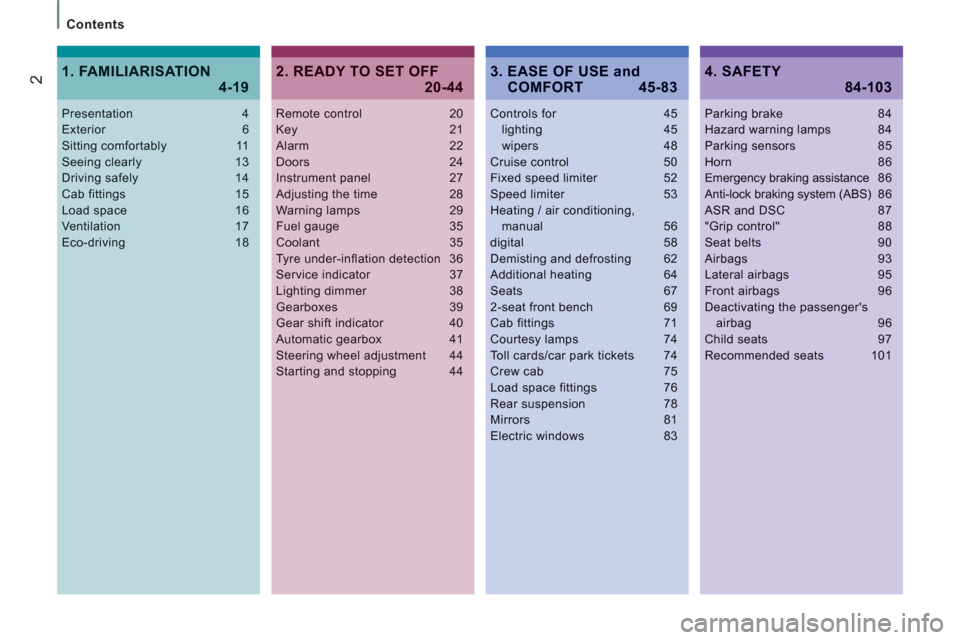
2
Contents
Remote control 20Key 21Alarm 22Doors 24Instrument panel 27Adjusting the time 28Warning lamps 29Fuel gauge 35Coolant 35Tyre under-inflation detection 36Service indicator 37Lighting dimmer 38Gearboxes 39Gear shift indicator 40Automatic gearbox 41Steering wheel adjustment 44Starting and stopping 44
Controls for 45lighting 45wipers 48Cruise control 50Fixed speed limiter 52Speed limiter 53Heating / air conditioning,manual 56digital 58Demisting and defrosting 62Additional heating 64Seats 672-seat front bench 69Cab fittings 71Courtesy lamps 74Toll cards/car park tickets 74Crew cab 75Load space fittings 76Rear suspension 78Mirrors 81
Electric windows 83
2. READY TO SET OFF
20-44
4. SAFETY
84-103
Presentation 4Exterior 6Sitting comfortably 11Seeing clearly 13Driving safely 14Cab fittings 15Load space 16Ventilation 17Eco-driving 18
1. FAMILIARISATION
4-19
Parking brake 84Hazard warning lamps 84Parking sensors 85Horn 86Emergency braking assistance 86Anti-lock braking system (ABS) 86ASR and DSC 87"Grip control" 88Seat belts 90Airbags 93Lateral airbags 95Front airbags 96Deactivating the passenger'sairbag 96Child seats 97Recommended seats 101
3. EASE OF USE and COMFORT 45-83
Page 12 of 248

Interior
10
CENTRE CONSOLE AND OVERHEAD
STORAGE UNIT
1.
Location of controls:
- central locking/unlocking,
- locking/unlocking the load space.
2.
Heating and/or air conditioning
controls.
3.
Location of the ticket/card storage or
controls:
- deactivation of the DSC,
- deactivation of the interior
protection alarm, alarm LED,
- deactivation of the parking
sensors.
4.
Storage compartment.
5.
Audio system or storage
compartment.
6.
Central adjustable vents.
7.
Hazard warning lamps switch.
8.
Screen or storage compartment.
9.
Courtesy lamp.
10.
Passenger's airbag deactivated
warning lamp.
11 .
Location of the ticket/card storage,
heated seat controls.
ADJUSTING THE TIME
- a centre console with screen: refer
to "Adjusting the date and time" in
section 9,
- a centre console without screen: refer to
"Instruments and controls" in section 2.
Depending on the configuration of your
vehicle, you have either:
Page 20 of 248

Interior
18
ECO-DRIVING
Eco-driving is a range of everyday practices that allow the motorist to optimise their fuel
consumption and CO
2 emissions.
Optimise the use of your
gearbox
With a manual gearbox, move off gently,
change up without waiting and drive by
changing up quite soon. If your vehicle has
the system, the gear shift indicator invites
you to change up; it is displayed in the
instrument panel, follow its instructions.
With an automatic or electronic gearbox,
stay in Drive "D"
or Auto "A"
, according to
the type of gearbox, without pressing the
accelerator pedal heavily or suddenly.
Control the use of your
electrical equipment
Before moving off, if the passenger
compartment is too warm, ventilate it by
opening the windows and air vents before
using the air conditioning.
Above 30 mph (50 km/h), close the windows
and leave the air vents open.
Switch off the headlamps and front
foglamps when the level of light does not
require their use.
Avoid running the engine before moving
off, particularly in winter; your vehicle will
warm up much faster while driving.
Drive smoothly
Maintain a safe distance between vehicles,
use engine braking rather than the
brake pedal, and press the accelerator
progressively. These practices contribute
towards a reduction in fuel consumption and
CO
2 emissions and also helps reduce the
background traffic noise.
If your vehicle has cruise control, make
use of the system at speeds above 25 mph
(40 km/h) when the traffic is flowing well.
As a passenger, if you avoid connecting
your multimedia devices (film, music,
video game...), you will contribute towards
limiting the consumption of electrical
energy, and so of fuel.
Disconnect your portable devices before
leaving the vehicle.
Remember to make use of equipment
that can help keep the temperature in the
passenger compartment down (sunroof
and window blinds...).
Switch off the air conditioning, unless it
has automatic digital regulation, as soon
as the desired temperature is attained.
Switch off the demisting and defrosting
controls, if not automatic.
Switch off the heated seat as soon as
possible.
Page 48 of 248

46
Steering mounted controls
Front
foglamps (green)
and rear fo
glamps (amber,
2nd rotation o
f the ring
forwards).
T
o switch off the front and rear
foglamps, turn the ring rearwards twice
in
succession.
In clear weather or in rain, both day
and night, rear foglamps dazzle and
their use is prohibited.
Do not for
get to switch them off when they
are no longer needed.
Automatic illumination of the headlamps
switches off the rear foglamps, but the front
foglamps remain on.
Daytime running lamps
Depending on the country in which the vehicle
is sold, the vehicle ma
y be equipped with
daytime running lamps. The dipped headlamps
come on when the vehicle is started.
Th
e instruments and controls
(instrument panel, screen, air
conditioning control panel, ...) are only
illuminated on switching to the automatic
illumination of headlam
ps mode or when the
lamps are switched on manually.
Front and rear foglamps
Rotate ring Bforwards to switch on and
rearwards to switch off. The status is
confirmed by the warning lamp in the
instrument panel.
These operate with the sidelamps and the
di
pped beam headlamps.
Front
foglamps (green,
1st rotation o
f the ring forwards).
This warning lamp comes on in
the instrument panel.
Page 58 of 248
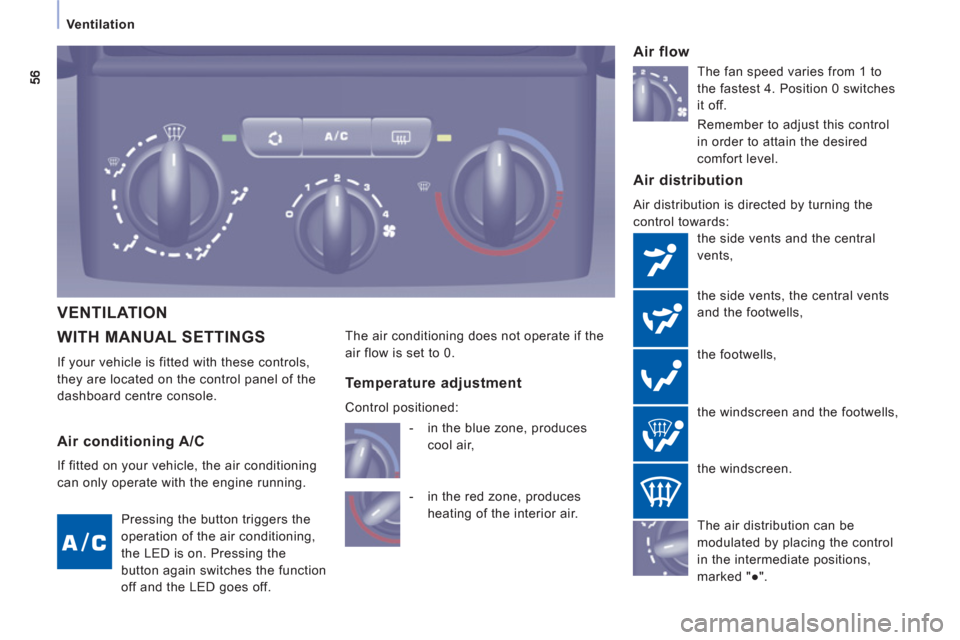
Ventilation
WITH MANUAL SETTINGS
If your vehicle is fitted with these controls,
the
y are located on the control panel of the
dashboard centre console.
Air distribution
Air distribution is directed by turning the
control towards:
t
he side vents and the central
vents,
t
he side vents, the central vents
and the
footwells,
the footwells,
the windscreen and the
footwells,
Air flow
The air conditioning does not operate if the
air flow is set to 0.
th
e windscreen.
Air conditioning A/C
If fitted on your vehicle, the air conditioning
can only operate with the engine running.
Pressing the button triggers the
operation of the air conditioning,
the LED is on. Pressin
g the
button a
gain switches the function
off and the LED goes off.
Temperature adjustment
Control positioned:
- in the red zone, produces
heating of the interior air.
- in the blue zone, produces
cool air,
Th
e air distribution can be
modulated by placing the control
in the intermediate positions,
m
arked "●". The
fan speed varies from 1 to
th
e fastest 4. Position 0 switches
it off.
Remember to ad
just this control
in order to attain the desired
comfort level.
VENTILATION
Page 59 of 248
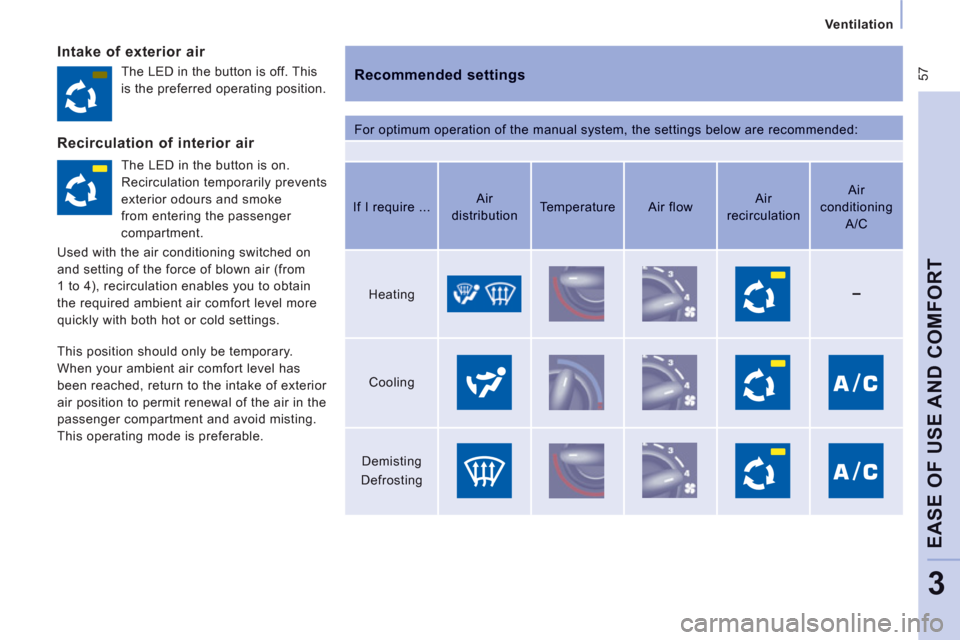
57
Ventilation
EASE OF USE AND COMFOR
T
3
Intake of exterior air
Recommended settings
For optimum operation of the manual system, the settings below are recommended: Th
e LED in the button is off. This
is the pre
ferred operating position.
Recirculation of interior air
The LED in the button is on.
Recirculation temporarily prevents
exterior odours and smoke
from entering the passenger
compartment.
Used with the air conditionin
g switched on
and settin
g of the force of blown air (from
1 to 4
), recirculation enables you to obtain
the re
quired ambient air comfort level more
quickly with both hot or cold settings.
This position should onl
y be temporary.
When your ambient air comfort level has
been reached, return to the intake o
f exterior
air position to permit renewal of the air in the
passenger compartment and avoid misting.
This operatin
g mode is preferable.
If I require ... Air
distribution
Te mperature
Air flow Air
recirculation
Air
conditioning
A/C
Heating
Cooling
Demisting
Defrosting
Page 60 of 248

58
Ventilation
DIGITAL AIR CONDITIONING WITH SEPARATE SETTINGS
Good practice
For maximum cooling or heating of the
passen
ger compartment, it is possible to exceed
the value 15 b
y turning until LO is displayed or
the value 27 b
y turning until HI is displayed.
For optimum com
fort, the difference between
the value displa
yed for the driver and for the
passen
ger should not be greater than 3. I
f your vehicle is fitted with this control
panel, it is located on the centre console.
On entering the vehicle, the inside
temperature ma
y be much colder (or
warmer
) than is comfortable. There is no
a
dvantage in changing the value displayed
in order to quickl
y reach the level of comfort
required. The system will use its maximum
performance to reach the comfort value set.
Page 61 of 248
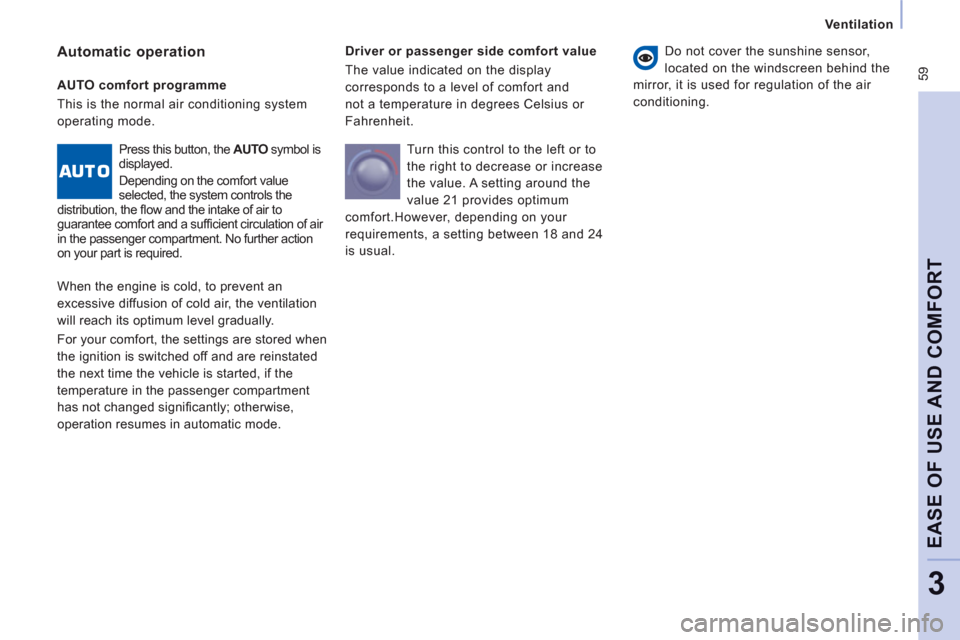
59
Ventilation
EASE OF USE AND COMFOR
T
3
Driver or passenger side comfort value
The value indicated on the display
corresponds to a level of comfort and
not a temperature in de
grees Celsius or
F
ahrenheit.
Automatic operation
Do not cover the sunshine sensor,
l
ocated on the windscreen behind the
mirror, it is used for regulation of the air
conditioning.
AUTO comfort programme
This is the normal air conditioning system
operat
ing mode.
Press this button, the
AUTO
symbol is
displayed.
Depending on the com
fort valueselected, the system controls the
distribution, the fl ow and the intake of air to
guarantee comfort and a suffi cient circulation of air
in the passenger compartment. No further action
on your part is required.
When the engine is cold, to prevent an
excessive diffusion of cold air, the ventilation
will reach its optimum level
gradually.
For
your comfort, the settings are stored when
the i
gnition is switched off and are reinstated
the next time the vehicle is started, i
f the
temperature in the passen
ger compartment
has not changed signifi cantly; otherwise,
operat
ion resumes in automatic mode. T
urn this control to the left or to
the right to decrease or increase
the value. A settin
g around the
value 21 provides optimum
comfort.However, depending on your
requirements, a settin
g between 18 and 24
i
s usual.
Page 62 of 248
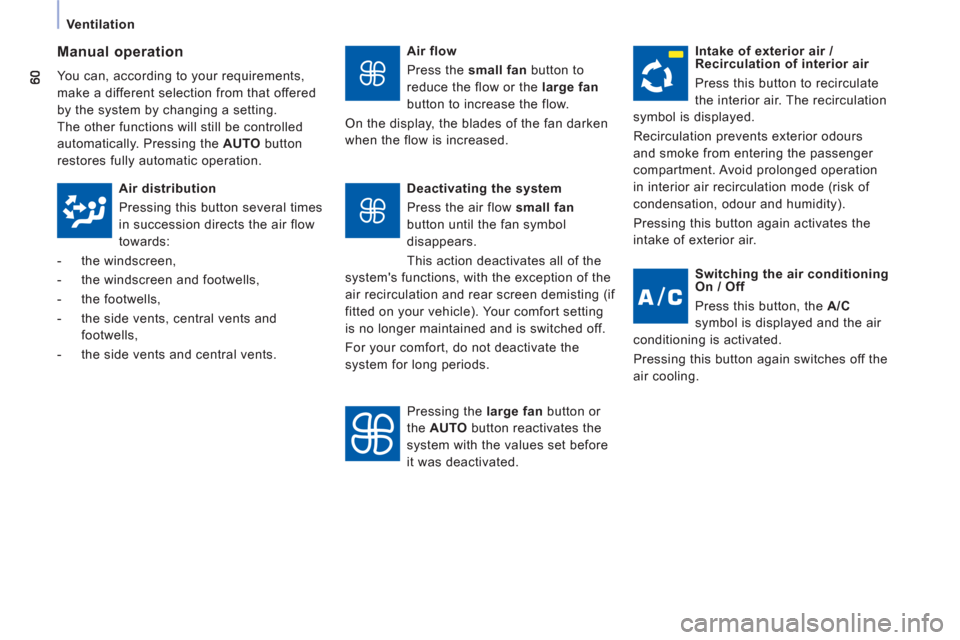
Ventilation
Air flow
Pr
ess the small fanbutton to
reduce the flow or the large fan
button to increase the flow.
On the display, the blades of the fan darken
wh
en the flow is increased.
Manual operation
You can, according to your requirements,
make a different selection from that offered
by the system by changing a setting.
Th
e other functions will still be controlled
automaticall
y. Pressing the AUTObutton
restores fully automatic operation.
Intake of exterior air /
Recirculation of interior air
Pr
ess this button to recirculate
the interior air. The recirculation
symbol is displayed.
Recirculation prevents exterior odours
and smoke
from entering the passenger
compartment. Avoid prolonged operation
in interior air recirculation mode
(risk of
condensation, odour and humidity).
Pressing this button again activates the
int
ake of exterior air.
Air distribution
Pressin
g this button several times
in
succession directs the air flow
t
owards:
- the windscreen,
- the windscreen and footwells,
- the footwells,
- the side vents, central vents and
footwells,
- the side vents and central vents.
Deactivating the system
Pr
ess the air flow small fan
button until the
fan symbol
disappears.
Thi
s action deactivates all of the
system's functions, with the exception of the
air recirculation and rear screen demisting (if
fitted on your vehicle). Your comfort setting
is no longer maintained and is switched off.
For
your comfort, do not deactivate the
system for long periods.
Pressin
g the large fan
button or
th
e AUTO
button reactivates the
system with the values set before
it w
as deactivated.
Switching the air conditioning
On / Off
Press this button, the A/C
symbol is displayed and the air
conditioning is activated.
Pressin
g this button again switches off the
a
ir cooling.
Page 63 of 248
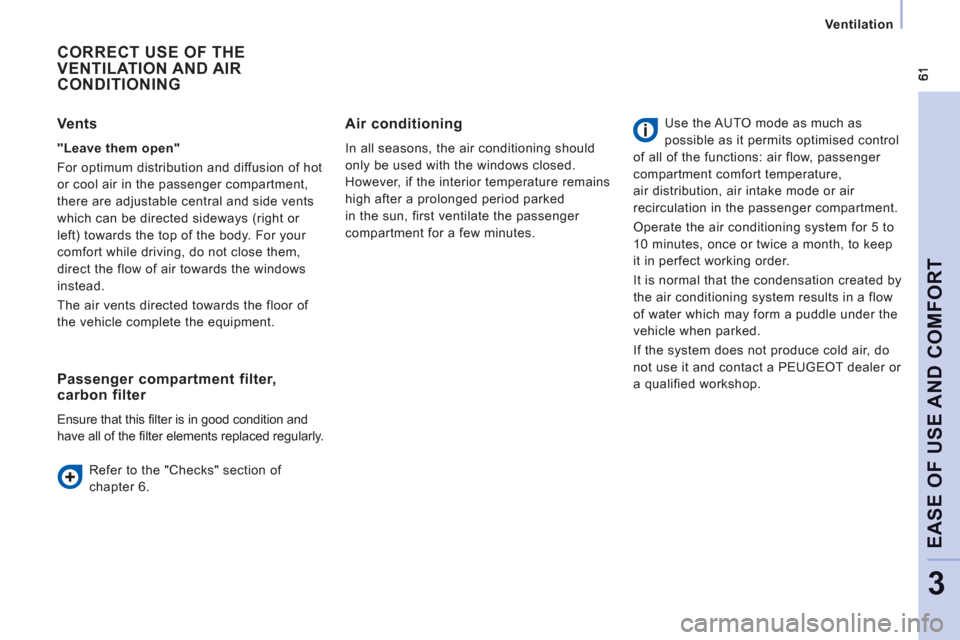
Ventilation
EASE OF USE AND COMFOR
T
3
CORRECT USE OF THE VENTILATION AND AIR
CONDITIONING
Passenger compartment filter, carbon filter
Ensure that this fi lter is in good condition and
have all of the fi lter elements replaced regularly.
Vents
"Leave them open"
For optimum distribution and diffusion of hot
or coo
l air in the passenger compartment,
there are ad
justable central and side vents
which can be directed sidewa
ys (right or
left) towards the top of the body. For your
comfort while driving, do not close them,
direct the flow of air towards the windows
instead.
Th
e air vents directed towards the floor of
the vehicle complete the equipment.
Re
fer to the "Checks" section of
chapter 6.
Air conditioning
In all seasons, the air conditioning should
only be used with the windows closed.
However, if the interior temperature remains
hi
gh after a prolonged period parked
in the sun,
first ventilate the passenger
compartment for a few minutes. Use the AUT
O mode as much as
possible as it permits optimised control
of all of the functions: air flow, passen
ger
compartment comfort temperature,
air distribution, air intake mode or air
recirculation in the passenger compartment.
Operate the air conditioning system for 5 to
10 minutes, once or twice a month, to keep
it in per
fect working order.
It is normal that the condensation created by
the air conditionin
g system results in a flow
of water which ma
y form a puddle under the
ve
hicle when parked.
If the s
ystem does not produce cold air, do
not use it and contact a PEUGEOT dealer or
a
qualified workshop.